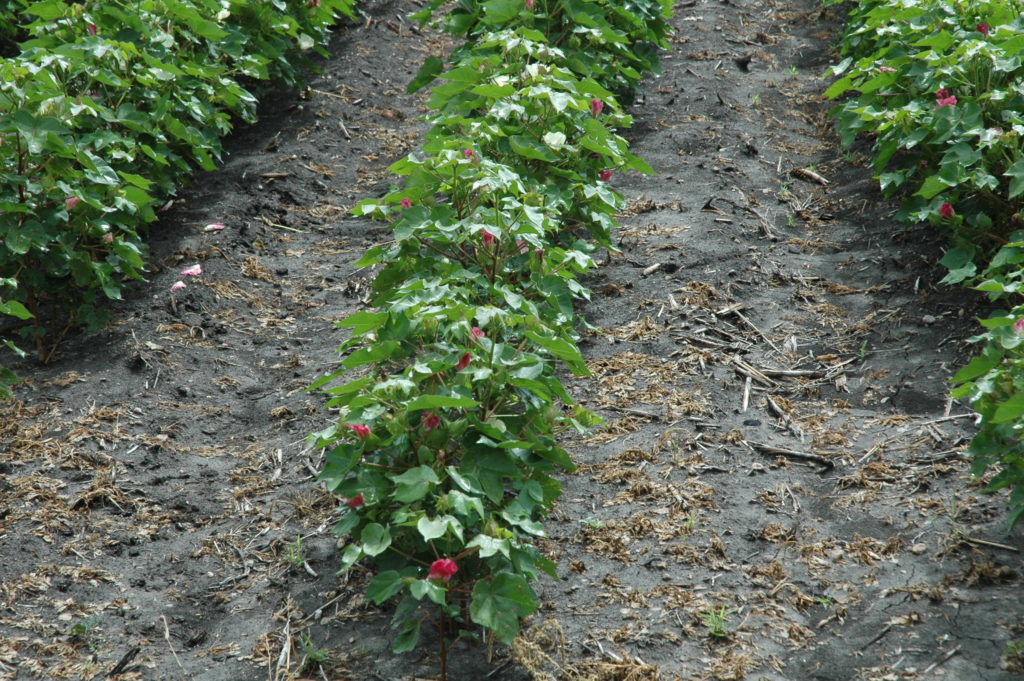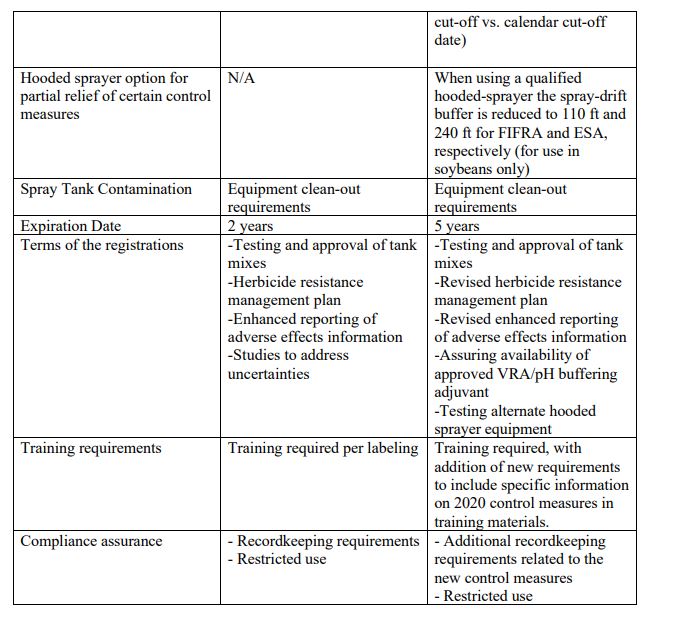The Environmental Protection Agency (“EPA”) has announced its decision to approve three dicamba-based herbicides for over the top use of cotton and soybeans for 2021-2025. This approval applies to Bayer’s XtendiMax, BASF’s Engenia, and Syngenta’s Tavium. Note that Corteva’s FeXapan was not included in this registration application, meaning that at least at this point, it remains unapproved for use until a registration has been issued.

TAMU AgriLife Communications photo
Background
In 2015, Bayer released new dicamba-resistant soybean and cotton seeds, called Xtend.
In 2016, the Environmental Protection Agency (EPA) granted conditional, two-year registrations to three of the dicamba products (XtendiMax, Engenia, and FeXapan). This conditional registration was set to expire in late 2018. On October 31, 2018, the EPA approved another conditional, two-year registration for the products. The amended registration included additional restrictions on use, including limiting the time of day when application can be made, limiting the number of applications and the length of time after planting the application can be made, and allowing only certified applicators to make applications. In doing so, the EPA considered both the benefits and risks of the products.
In April 2019, the EPA issued a registration for Tavium, which was set to expire in December 2020.
To say that these products were controversial would be an understatement. There were numerous legal challenges related to these dicamba formulations, including claims related to the timing of releasing the seed versus the pesticides, drift claims against the manufacturers and against neighboring landowners, and challenges that the EPA’s approval of the products was improper.
For more information on the background and litigation, click here to read “The Deal with Dicamba” blog series, authored by Brigit Rollins of the National Agricultural Law Center.
June 2020 US Court of Appeals for the Ninth Circuit Decision
On Wednesday, June 3, 2020, the United States Court of Appeals for the Ninth Circuit issued a ruling in National Family Farm Coalition v. EPA, vacating the federal registration for three dicamba herbicide products, Xtendimax, FeXapan, and Engenia. [Read full opinion here and read my blog post discussing here.] Specifically, the court held that the EPA failed to properly acknowledge certain risks related to the pesticides, it violated the Federal Insecticide Fungicide and Rodenticide Act. Thus, the court vacated the registration. This left states and producers scrambling to determine what this meant on a practical level for continued use of these products in the midst of the growing season. The following week, the EPA issued a final cancellation order for the three products in light of the court’s decision. That cancellation order prohibited the distribution, use, or sale of the products, but did allow for certain uses of “existing stocks,” including allowing application of existing stocks through July 31.
EPA Registration for 2021-2025
Three dicamba products–Xtendimax, Engenia, and Tavium applied to the EPA for registration going forward into future growing seasons. On October 27, 2020, the Environmental Protection Agency (“EPA”) issued its decision on the registration application for three dicamba-based pesticide products. To view the entire docket and EPA information, click here.
The EPA approved these products for use from 2021-2025, but the registration includes some additional labeling restrictions and changes of which farmers need to be aware.
Nationwide cutoff date: All three products now have nationwide cutoff dates. For soybeans, application is allowed through June 30, and for cotton, the cutoff date is July 30.
Increased downwind buffer: The required downwind buffer will be increased from 110′ to 240′ in most areas, and 310′ in areas where endangered species are located. If a qualified hooded sprayer is used, this may be decreased for soybeans only.
Required use of pH buffering agent: Applicators will be required to document their use of a VRA/pH buffering agent in the tank for every application in order to reduce volatility.
Simplified label: Going forward, the label will be simplified, likely aimed at addressing concern over the complexity of the 2018 label noted by the court. Going forward, the label will include only pre-and post-emergence uses for dicamba tolerant cotton and soybean crops, and will not include information for other non-dicamba tolerant uses. The label is also simplified with the use of a clear calendar cut-off date rather than crop growth stage restrictions.
Additional recordkeeping requirements: There will be additional recordkeeping requirements on top of those generally applicable to restricted use pesticides, including records related to the use of the VRA/pH buffering agent, the application date, proof of training, and infield buffer distances.
States not allowed to use Section 24(c) for label restrictions: In a major change for state regulators, the EPA will no longer allow states to further restrict the federal label through the use of FIFRA Section 24(c), the “special local needs labels.” While expansions may still be allowed under Section 24(c), restrictions will not. Instead, any additional restrictions must be done through Section 24(a). This will require a much slower, more cumbersome process to further restrict the federal label. Essentially, if a state wanted to impose more restrictions than the federal label, as some states have previously done with earlier cut off dates, the state regulators would have to go through a state law or rulemaking process. For more information on this change and its potential impact, click here for a great article by Emily Unglesbee. This may also be more broad reaching than dicamba, as EPA has indicated it intends this to be its practice for other pesticides as well, stating, ” EPA has determined that moving forward, EPA may disapprove any state registrations under FIFRA section 24(c) that further restrict use of pesticides registered by EPA, regardless of the chemicals involved. If a state wishes to further restrict use of a pesticide, they must do so under section 24(a) of FIFRA.”
Many other restrictions, including wind speed, sprayer speed, number of applications per year, and the daily application window remained unchanged.
The chart below was published by the EPA to help clarify the changes.


The EPA did note in its memorandum supporting the registration that it did consider the issues raised by the US Court of Appeals for the Ninth Circuit in the National Family Farm Coalition case.
Now What?
The Center for Food Safety, one of the plaintiffs in the Ninth Circuit litigation that resulted in the 2018 label being vacated, has stated that it will “most certainly challenge these unlawful approvals.” Stay tuned and we will do our best to keep producers up to date.












